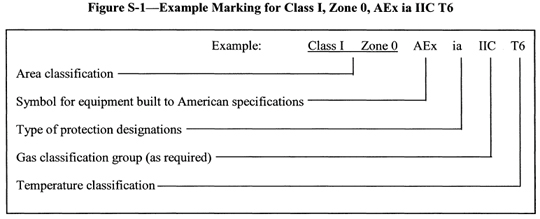- Part Number:1910
- Part Number Title:Occupational Safety and Health Standards
- Subpart:1910 Subpart S
- Subpart Title:Electrical
- Standard Number:
- Title:Hazardous (classified) locations.
- GPO Source:
Equipment shall be approved not only for the class of location, but also for the ignitable or combustible properties of the specific gas, vapor, dust, or fiber that will be present.
Note to paragraph (c)(2)(i) of this section: NFPA 70, the National Electrical Code, lists or defines hazardous gases, vapors, and dusts by "Groups" characterized by their ignitable or combustible properties.
Equipment of the nonheat-producing type, such as junction boxes, conduit, and fittings, and equipment of the heat-producing type having a maximum temperature not more than 100 ºC (212 ºF) need not have a marked operating temperature or temperature range;
Electric equipment suitable for ambient temperatures exceeding 40 ºC (104 ºF) shall be marked with both the maximum ambient temperature and the operating temperature or temperature range at that ambient temperature; and
Safe for the hazardous (classified) location. Equipment that is safe for the location shall be of a type and design that the employer demonstrates will provide protection from the hazards arising from the combustibility and flammability of vapors, liquids, gases, dusts, or fibers involved.
Note to paragraph (c)(3) of this section: The National Electrical Code, NFPA 70, contains guidelines for determining the type and design of equipment and installations that will meet this requirement. Those guidelines address electric wiring, equipment, and systems installed in hazardous (classified) locations and contain specific provisions for the following: wiring methods, wiring connections; conductor insulation, flexible cords, sealing and drainage, transformers, capacitors, switches, circuit breakers, fuses, motor controllers, receptacles, attachment plugs, meters, relays, instruments, resistors, generators, motors, lighting fixtures, storage battery charging equipment, electric cranes, electric hoists and similar equipment, utilization equipment, signaling systems, alarm systems, remote control systems, local loud speaker and communication systems, ventilation piping, live parts, lightning surge protection, and grounding.
All threaded conduit shall be threaded with an NPT (National (American) Standard Pipe Taper) standard conduit cutting die that provides ¾-in. taper per foot. The conduit shall be made wrench tight to prevent sparking when fault current flows through the conduit system and to ensure the explosionproof or flameproof integrity of the conduit system where applicable.
Flameproof "d" - This protection technique is permitted for equipment in the Class I, Zone 1 locations for which it is approved.
Type of protection "n" -- This protection technique is permitted for equipment in the Class I, Zone 2 locations for which it is approved. Type of protection "n" is further subdivided into nA, nC, and nR.
Oil Immersion "o" -- This protection technique is permitted for equipment in the Class I, Zone 1 locations for which it is approved.
Increased safety "e" -- This protection technique is permitted for equipment in the Class I, Zone 1 locations for which it is approved.
Encapsulation "m" -- This protection technique is permitted for equipment in the Class I, Zone 1 locations for which it is approved.
Powder Filling "q" -- This protection technique is permitted for equipment in the Class I, Zone 1 locations for which it is approved.
A Class I, Division 1 or Division 2 location may be reclassified as a Class I, Zone 0, Zone 1, or Zone 2 location only if all of the space that is classified because of a single flammable gas or vapor source is reclassified.
Note to paragraph (g)(4) of this section: Low ambient conditions require special consideration. Electric equipment depending on the protection techniques described by paragraph (g)(3)(i) of this section may not be suitable for use at temperatures lower than -20 ºC (-4 ºF) unless they are approved for use at lower temperatures. However, at low ambient temperatures, flammable concentrations of vapors may not exist in a location classified Class I, Zone 0, 1, or 2 at normal ambient temperature.
Symbol "AEx;"
Temperature classification, except for intrinsically safe apparatus.
Note to paragraph (g)(5)(ii)(B) of this section: An example of such a required marking is "Class I, Zone 0, AEx ia IIC T6." See Figure S-1 for an explanation of this marking.
Equipment that the employer demonstrates will provide protection from the hazards arising from the flammability of the gas or vapor and the zone of location involved and will be recognized as providing such protection by employees need not be marked.
Note to paragraph (g)(5)(ii)(C) of this section: The National Electrical Code, NFPA 70, contains guidelines for determining the type and design of equipment and installations that will meet this provision.

Class I, Zone 0 = Area Classification, AEx = Symbol for equipment built to American specifications, ia = Type of protection designations, IIC = Gas classification group (as required), T6 = Temperature Classification
[46 FR 4056, Jan. 16, 1981; 46 FR 40185, Aug. 7, 1981; 72 FR 7210, Feb. 14, 2007]

